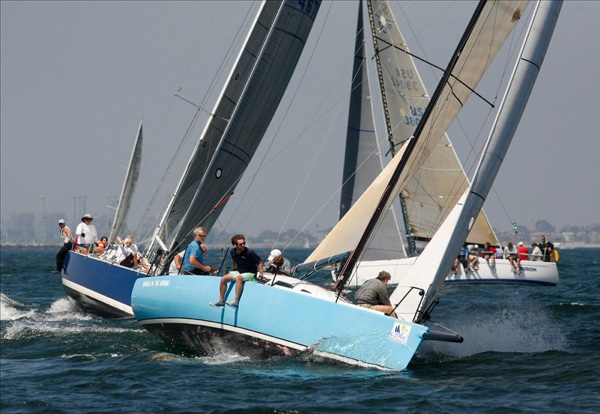
Local sailmakers Ullman Sails has done a great job building Long Beach Race Week (LBRW.org) into Southern California’s premier big-boat event. Every year, hundreds of local off-shore racing sailors make their way to Long Beach for this regatta. This year’s LBRW, held last weekend, saw great winds and fun, open offshore racecourses, which combined for some of our region’s best big-boat racing in the last 12 months.
For this year’s LBRW, I had the pleasure of stepping onto Pete Woodworth’s new (to him) Schock 40, Napalm in the Morning. I had sailed Shock 40s (S-40s) a bunch about 10 years ago, so I was intrigued by how much this then-radical design would stand up to the latest generation 40-foot racers.
When the Schock 40s were introduced in the late 1990s, they were a revolutionary boat due to their extreme light weight (just 7,000 pounds, more than 3,000 of that in the keel bulb); they were also known for their radical hydraulic canting keel that could pivot their keel to weather. Even to this day, the S-40 remains among the fastest production 40-foot monohulls ever built in this size range.
Looking out at racing boats on the line with us, it’s clear that the original S-40 design helped inspire a new generation of ultra-lightweight racing keelboats that focus on putting relatively more weight into a ballast torpedo. For the Schock 40, the keel bulb had almost as much weight than the rest of the boat combined. With modern composite materials like carbon fiber, and with deeper keel struts now feasible, the sail area to displacement characteristics of the Schock 40 are only now being seen in modern racing sailboats.
On board Napalm in the Morning (the name is a nod to Robert Duvall’s classic speech in “Apocalypse Now”), we more than had our hands full with this original canting-keel 40-footer. The now 10-year-old Schock 40 has a radical hydraulic ram that kicks our keel 30 degrees to weather on each tack. While the canting keel is a big advantage in some conditions, this design feature can add its own share of sailing challenges for a rookie crew.
To say that the Schock 40 is “tender” is an understatement. We found that any poor maneuvers and/or sail-handling mistakes usually lead to wild crashes. As the breeze built to 20-plus knots, even simple maneuvers, like tacking, could challenge our experienced crew because they required such close coordination between sail trimmers and driver (we ended up in irons a couple times).
I was trimming main, and I more than had my hands full during tacks that required unusual tasks like adjusting the front canard rudder, and/or helping cant the keel to the opposite side. As I hadn’t been on a Schock 40 in 10 years, I was cruelly reminded this weekend how slight boat handling errors could end up in spectacular spin-outs and broaches.
We even had to re-learn basic maneuvers like how to tack a big main and a small No. 4 jib in choppy 20-plux-knot conditions (i.e. be ready to dump the mainsheet!). And even though our crew was full of young dinghy sailors from the UCLA sailing team, our whole crew on the boat was pretty much “worked” by the end of the weekend.
Not surprisingly, new modern keelboat racers in our class range now often use similar deeper keels and lightweight composite construction techniques that come closer to matching the power-to-weight ratios first realized in the Schock-40 design. We saw a number of 37- to 41-foot keelboats that could nearly match our speed around the racecourse, especially upwind. We also saw that newer fixed-keel designs were not nearly as tender as the S-40. Nevertheless, one of the best features of a canting keel remains; after we rounded the weather make and got powered up, none of our competition in the 40-foot class could match our top speeds downwind with our chute up.
After the smoke cleared, we ended up in third place in our class for the weekend, and I had a renewed crash course in boat handling and sail trim.
I’m also mindful of how much our sport continues to progress, and I enjoyed seeing how modern designs have come to incorporate some of the changes ushered in by the Schock 40. On the scoreboard we ended up just a point behind the brand new Santa Cruz 37 design Tiburon, who finish only second place in our class.
Given that Pete has owned the Napalm in the Morning for just about three months, and with a new pick-up crew for the weekend, we’ll take it.
Other top Local Finishers in Long Beach Race Week Included:
PHRF-1: 3rd overall – It’s OK, Tres Gordo Racing, BYC; 4th overall – Rebel Yell, David Team, NHYC.
PHRF-2: 3rd overall – Napalm in the Morning, Pete Woodworth.
PHRF-3: Exigent – Taylor Grant, NHYC.
Catalina 37: Team Ayers Satariano, Bruce Ayers, NHYC.




